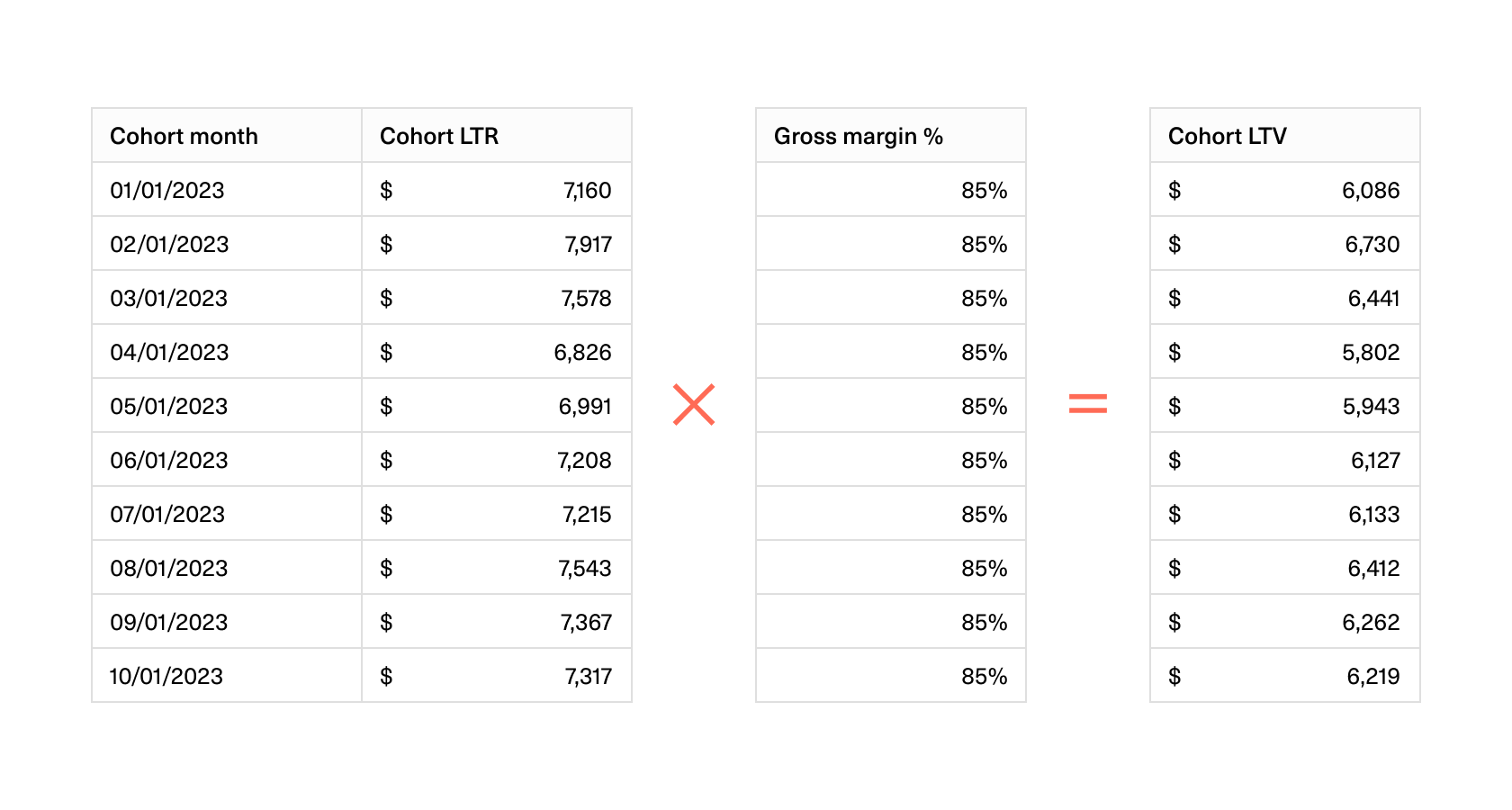The Guide to
SaaS Metrics
The Guide to
SaaS Metrics
Table of Contents
LTV: Customer Lifetime Value
What is LTV?
While Lifetime Revenue (LTR) is a straightforward estimate of the total revenue a business can expect from a customer across the duration of their relationship, Lifetime Value (LTV) takes this concept further by accounting for the costs associated with servicing that customer (in other words, your Cost of Goods Sold, or COGS):
In this way, LTV offers a fuller picture of the revenue potential and the value a business extracts from a customer relationship. It's important to differentiate between LTR and LTV because the costs of servicing a customer are real and ongoing, and they consistently eat into a company's ability to escape the Triangle of Despair.
A strong LTV suggests that the cost of servicing customers will not exceed the value they bring to the business. This is vital, as startups will ultimately be valued based on their profitability.
Monitoring LTV across cohorts can also demonstrate the impact of strategic changes to the business or shifting market conditions. Did last quarter's additional investment in event and podcast sponsorship actually lead to the acquisition of higher-LTV customers? Your LTV by cohort will show you that.
High vs. Low LTV
A high LTV typically reflects strong customer loyalty (which in turn suggests you've reached product-market fit) and indicates that you'll be able to rely on loyal customers to increase their spend (i.e., expand) over time.
Conversely, a low or decreasing LTV highlights potential issues with customer satisfaction, product-market fit, or pricing. This means that what your customers are asked to spend is not aligned with the value they are receiving, causing them to churn or contract their spend over time.
A low LTV could also mean that your cost of servicing customers is unsustainably high, offsetting the revenue from each customer. This indicates that you may have an issue with operational efficiency, draining resources that could otherwise be invested back into product innovation (i.e., R&D) or growth.
How to calculate LTV
Start with your LTR — either your cohort LTR or aggregate LTR metric. This is your estimate of the revenue potential of an average customer relationship.
To arrive at the profit potential of a customer relationship, simply multiply LTR by your Gross Margin (which accounts for the impact of your COGS).

Your COGS represents the ongoing costs of retaining and servicing customers. These can include line items like hosting fees, payment processing fees, data and security costs, and costs associated with your customer support team.
Think of it this way: if you were to cease all acquisition efforts tomorrow, what would it cost to maintain your existing customer base? You'll want to account for those costs in your LTV calculation.
What isn't included are any non-recurring, upfront costs—your initial investment in product development and your Customer Acquisition Cost (CAC). Think of these as sunk costs that occur before the customer relationship begins—including them would skew your estimate of that relationship's profitability.
One caveat: This calculation assumes that COGS remains relatively stable throughout a customer's lifecycle, which is true for most SaaS businesses. However, some businesses may see frontloaded COGS (e.g., due to significant upfront costs to stand up a customer) or backweighted (e.g., server hosting fees that scale as customers add more seats). Be aware of how your COGS ramps over time, and contextualize any LTV calculations as being over or under-optimistic. This will matter most when you go to calculate your Payback Period.
How to optimize LTV
It's important to note that LTV should not be optimized in isolation, just as with LTR. While LTV accounts for the costs of maintaining a customer relationship, it does not account for upfront CAC. As a result, optimizing for LTV alone may negatively impact the economics of the business if it causes you to prioritize high-LTV but higher-CAC segments. To account for this, always consider LTV in relation to CAC (see LTV:CAC).
Also, remember that LTV is a predictive metric, meaning it’s based on historical data. Optimizing against LTV means making assumptions about past customer behaviour for incoming customer cohorts. To account for this, ensure that you are frequently recalculating LTV and revisiting the assumptions and data on which it's based.
Given that, let's look at how you might maximize the LTV component of the LTV:CAC ratio. There are two basic levers: increasing LTR and decreasing COGS.
To manage against COGS, you'll need to improve service efficiency by reducing the cost of maintaining your customer base without compromising on the quality to the point where it increases churn (which would negatively impact LTV). Here are a few practical steps you can take:
- Negotiate better vendor terms: Review and renegotiate contracts with third-party service providers, such as database, analytics, or support tools.
- Improve customer support efficiency: Invest in better training, automation, and tools. Streamline support workflows, such as triaging requests, so human agents can focus on high-value customers. Look into AI as a possible way to improve support efficiency.
- Reduce hosting and server costs: Transition to more cost-effective cloud service providers or better optimize your infrastructure set-up and usage.